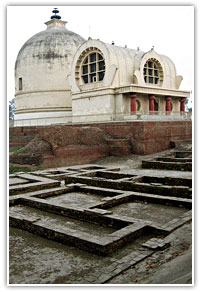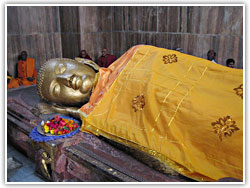|
|
Kushinagar, Uttar Pradesh
.............................................................................................................................................................................. |
|
Information about Kushinagar
Kushinagar or Kushinara of Yore is the place where
the Lord Buddha died, at the age of 80 and was
cremated and achieved the state of Parinirvana. Kushinagar is situated about 55 kms. away from
Gorakhpur and a revered place for Buddhist
pilgrims. In ancient times, Kushinagar was known
as Kushinara and was a small town of not great
significance in the Malla kingdom. The main
tourist attraction in Kushinagar is the
Mahaparinirvana temple, containing the reclining
statue of Lord Buddha.
History of Kushinagar
In ancient times, Kushinagar was known as Kushinara and
was a small town of not great significance in the Malla
dynasty. The whole area was occupied until the
11th century. The actual site of the original town
has not been established, but the site of the
Buddha’s |
 |
|
|
death
was one of the four major sites of Buddhist pilgrimage.
It was here that the Buddha died and was cremated and
achieved the Parinirvana. The last rites were performed
with all the honour that is due to a universal monarch (Chakravartin),
as he was held in reverence by all people. The kings of
eight Indian states of the Gangetic basin came for the
funeral rites and divided his ashes in eight parts. Each
king carried these back to his kingdom and built a
‘Stupa’ over the mortal remains of Lord Buddha. There
are eight groups of monasteries, stupas and images,
indicating that Kushinagar was a substantial community.
On the Buddha’s death, the various monasteries were
established which flourished until the last Buddhist
monastery was destroyed at Nalanda in the 13th century.
There were eight groups of monasteries, stupas and
images, indicating that Kushinagar was a substantial
community. It was here that the Tathagata, the reciter
of truth, breathed his last days. The whole of
Kushinagar was turned into a memorial site with stupas
and Gupta period Chaitayas and Viharas, built by the
kings. Fa Hien, Hieun Tsang and I Tsing, the Chinese
travellers visited Kushinagar during different centuries
and recorded a graphic account of the place which later
fell to bad times, due to lack of patronage. A thousand
years passed before the stupa and the temple were
cleared in the 1880s and excavations of the stupa were
begun by the Archaeological Survey of India in 1904-5,
following clues left in the writings of the Chinese
travelers. A shaft was driven through the centre of the
stupa which brought to light a copper-plate placed on
the mouth of a relic casket in the form of a copper
vessel with charcoal, cowries, precious stones and a
gold coin of Kamaragupta I.
Tourist
Attractions in Kushinagar
The tourist attractions in Kushinagar are the
Mahaparinirvana Temple, Mata Kunwar Shrine and Rambhar
Stupa. Apart from this, a Chinese Temple, a Buddhist
Temple, a Tibetan Temple and the Indo-Japan-Srilanka
Buddhist Centre are the religious place for pilgrims. |
|
|
|
Mahaparinirvana Temple
The Mahaparinirvana Temple is dedicated to the
Lord Buddha where he attained Parinirvana. This
temple has a reclining statue of Lord Buddha. This
statue was excavated in 1876 at the temple, and
one of the most momentous sight for the devotees.
This statue was brought from Mathura by Haribala,
a devout monk, during the reign of King Kumara
Gupta in the 5th Century AD. This temple is
visited by thousands of Buddhist pilgrims every
year from all parts of the world. |
 |
|
|
|
|
Mata Kunwar Shrine
Mata Kunwar Shrine contains a 10th century blue schist
image of Lord Buddha.
Mukutabandhana Stupa
The Mukutabandhana Stupa is one of the most interesting
structures, built by the Malla dynasty to house the
Buddha’s relics after the cremation.
Rambhar Stupa
Rambhar Stupa is the spot where Lord Buddha was cremated
and his relics were divided into eight equal parts.
Excursion from Kushinagar
Aligarh
The word 'Aligarh' means “the high fort”. Before the
first Muslim invasion, Aligarh was a Rajput stronghold.
From 1194 it was administered by Muslim Governors
appointed by the King of Delhi. The fort was built in
1524 and subsequently reinforced by French and then
British engineers. With the decline of the Mughal
Empire, it fell into Jat, Maratha and Rohilla hands
before being taken by the British under Lord Lake in
1803. The Mutiny of 1857 quickly spread from Meerut when
the 9th Native Infantry went off to join the rebels at
Delhi. The British regained control five months later.
There are a number of mosques and also the Aligarh
Muslim University which was founded by Sir Saiyad Ahmad
Khan in 1875 under the name of the Anglo-Oriental
College and modeled on the Oxford and Cambridge
collegiate system.
Kannauj
Kannauj used to be on the banks of the Ganga. Now it is
several km to its south. Kannauj was Harsha’s capital in
the 7th century and later that of the Tomar and Rathore
Rajputs. Mahmud of Ghazni left his devastating mark in
1018 when he sacked it and Qutb-ud-in-Aibak took it in
1194 forcing the Rathors to flee to Rajasthan. There is
little of interest however, except the Archaeological
Museum with its collection of sculptures from the area,
some dating from the 1st and 2nd centuries AD, the
Shrine of Raja Ajaipal and the Jama Masjid which was
converted from a Hindu temple by Ibrahim Shah of Jaunpur
at the turn of the 15th century.
How to reach Kushinagar
By Air:
The nearest airport is located in Gorakhpur, about 62
kms. away.
By Rail:
The nearest railway station is located in Gorakhpur
which is connected with Lucknow, Varanasi and other
cities.
By Road:
Kushinagar is well connected by road with all major
cities like Lucknow, Gorakhpur, Ayodhya, Allahabad and
Varanasi. |
|
|
|